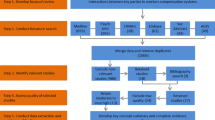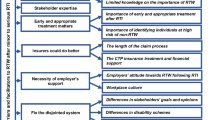Abstract
Purpose Many industrialised nations have systems of injury compensation and rehabilitation that are designed to support injury recovery and return to work. Despite their intention, there is now substantial evidence that injured people, employers and healthcare providers can experience those systems as difficult to navigate, and that this can affect injury recovery. This study sought to characterise the relationships and interactions occurring between actors in three Australian injury compensation systems, to identify the range of factors that impact on injury recovery, and the interactions and inter-relationships between these factors. Methods This study uses data collected directly from injured workers and their family members via qualitative interviews, analysed for major themes and interactions between themes, and then mapped to a system level model. Results Multiple factors across multiple system levels were reported by participants as influencing injury recovery. Factors at the level of the injured person’s immediate environment, the organisations and personnel involved in rehabilitation and compensation processes were more commonly cited than governmental or societal factors as influencing physical function, psychological function and work participation. Conclusions The study demonstrates that injury recovery is a complex process influenced by the decisions and actions of organisations and individuals operating across multiple levels of the compensation system. Changes occurring ‘upstream’, for instance at the level of governmental or organisational policy, can impact injury recovery through both direct and diffuse pathways.

Similar content being viewed by others
References
Takala J, Hamalainen P, Saarela KL, Yun LY, Manickam K, Jin TW, et al. Global estimates of the burden of injury and illness at work in 2012. J Occup Environ Hyg. 2014;11(5):326–337.
Liberty Mutual Research Institute for Safety. 2013 Liberty Mutual Workplace Safety Index. Liberty Mutual Research Institute for Safety, Boston. 2013. http://www.libertymutualgroup.com/researchinstitute. Accessed 18 Oct 2017.
Lane TJ, Collie A, Hassani-Mahmooei B. Work-related injury and illness in Australia, 2004 to 2014. What is the incidence of work-related conditions and their impact on time lost from work by state and territory, age, gender and injury type? Melbourne: Institute for Safety Compensation and Recovery Research; 2016. Report No. 118-0616-R02.
SafeWork Australia. The cost of work-related injury and illness for Australian employers, workers and the community: 2012-13. Canberra: Commonwealth of Australia; 2016.
Collie A, Lane TJ, Hassani-Mahmooei B, Thompson J, McLeod C. Does time off work after injury vary by jurisdiction? A comparative study of eight Australian workers’ compensation systems. BMJ Open. 2016;6(5):e010910.
Cullen KL, Irvin E, Collie A, Clay F, Gensby U, Jennings PA, et al. Effectiveness of workplace interventions in return-to-work for musculoskeletal, pain-related and mental health conditions: an update of the evidence and messages for practitioners. J Occup Rehabil. 2017;28(1):1–15.
Newnam S, Collie A, Vogel AP, Keleher H. The impacts of injury at the individual, community and societal levels: a systematic meta-review. Public Health. 2014;128(7):587–618.
Newnam S, Petersen A, Keleher H, Collie A, Vogel A, McClure R. Stuck in the middle: the emotional labours of case managers in the personal injury compensation system. Work 2016;55(2):347–357.
Harris I, Mulford J, Solomon M, van Gelder JM, Young J. Association between compensation status and outcome after surgery: a meta-analysis. JAMA 2005;293(13):1644–1652.
Kilgour E, Kosny A, McKenzie D, Collie A. Interactions between injured workers and insurers in workers’ compensation systems: a systematic review of qualitative research literature. J Occup Rehabil. 2015;25(1):160–181.
Brijnath B, Mazza D, Singh N, Kosny A, Ruseckaite R, Collie A. Mental health claims management and return to work: qualitative insights from Melbourne, Australia. J Occup Rehabil. 2014;24(4):766–776.
Kosny A, Brijnath B, Singh N, Allen A, Collie A, Ruseckaite R, et al. Uncomfortable bedfellows: employer perspectives on general practitioners’ role in the return to work process. Policy Pract Health Saf 2015;13(1):65–76.
Kilgour E, Kosny A, McKenzie D, Collie A. Healing or harming? Healthcare provider interactions with injured workers and insurers in workers’ compensation systems. J Occup Rehabil. 2015;25(1):220–239.
Brijnath B, Mazza D, Kosny A, Bunzli S, Singh N, Ruseckaite R, et al. Is clinician refusal to treat an emerging problem in injury compensation systems? BMJ Open. 2016;6(1):e009423.
Mazza D, Brijnath B, Singh N, Kosny A, Ruseckaite R, Collie A. General practitioners and sickness certification for injury in Australia. BMC Fam Pract. 2015;16(1):100. https://doi.org/10.1186/s12875-015-0307-9.
Anaf S, Drummond C, Sheppard LA. Combining case study research and systems theory as a heuristic model. Qual Health Res. 2007;17(10):1309–1315.
Goode N, Salmon PM, Lenne MG, Hillard P. Systems thinking applied to safety during manual handling tasks in the transport and storage industry. Accid Anal Prev. 2014;68:181–191.
Rasmussen J. Risk management in a dynamic society: a modelling problem. Saf Sci. 1997;27(2–3):183–213.
Leveson N. A new accident model for engineering safer systems. Saf Sci. 2004;42(4):237–270.
Sterman JD. Learning from evidence in a complex world. Am J Public Health. 2006;96(3):505–514.
Sturmberg JP, O’Halloran DM, Martin CM. People at the centre of complex adaptive health systems reform. Med J Aust. 2010;193(8):474–478.
Keshavarz N, Nutbeam D, Rowling L, Khavarpour F. Schools as social complex adaptive systems: a new way to understand the challenges of introducing the health promoting schools concept. Soc Sci Med. 2010;70(10):1467–1474.
Gabbe BJ, Cameron PA, Williamson OD, Edwards ER, Graves SE, Richardson MD. The relationship between compensable status and long-term patient outcomes following orthopaedic trauma. Med J Aust. 2007;187(1):14–17.
Beardwood BA, Kirsh B, Clark NJ. Victims twice over: perceptions and experiences of injured workers. Qual Health Res. 2005;15(1):30–48.
Akkermans AJ. Reforming personal injury claims settlement: paying more attention to emotional dimension promotes victim recovery. 2009. http://ssrn.com/abstract=1333214. Accessed 26 Feb 2009.
Jetha A, Pransky G, Fish J, Hettinger LJ. Return-to-work within a complex and dynamic organizational work disability system. J Occup Rehabil. 2016;26(3):276–285.
Salmon PM, Read GJM, Stanton NA, Lenne MG. The crash at Kerang: investigating systemic and psychological factors leading to unintentional non-compliance at rail level crossings. Accid Anal Prev. 2013;50:1278–1288.
Newnam S, Goode N, Salmon P, Stevenson M. Reforming the road freight transportation system using systems thinking: an investigation of Coronial inquests in Australia. Accid Anal Prev. 2017;101:28–36.
Luke DA, Stamatakis KA. Systems science methods in public health: dynamics, networks, and agents. Annu Rev Public Health. 2012;33:357–376. https://doi.org/10.1146/annurev-publhealth-031210-101222.
Braun V, Clarke V. Using thematic analysis in psychology. Qual Res Psychol. 2006;3(2):77–101.
Wang W, Chen Y, Huang JP. Heterogeneous preferences, decision-making capacity, and phase transitions in a complex adaptive system. Proc Natl Acad Sci USA. 2009;106(21):8423–8428.
Glouberman S, Gemar M, Campsie P, Miller G, Armstrong J, Newman C, et al. A framework for improving health in cities: a discussion paper. J Urban Health. 2006;83(2):325–338.
Olsson P, Folke C, Berkes F. Adaptive comanagement for building resilience in social-ecological systems. Environ Manag. 2004;34(1):75–90.
Jetha A, Pransky G, Hettinger LJ. Capturing complexity in work disability research: application of system dynamics modeling methodology. Disabil Rehabil. 2016;38(2):189–194.
Hopkins A. Lessons from Longford: the ESSO gas plant explosion. Sydney: CCH Australia Ltd; 2000.
Thompson J, McClure R, DeSilva A. A complex systems approach for understanding the effect of policy and management interventions on health system performance. Conference of the Computational Social Science of the Americas; Santa Fe: ACM; 2017.
Epstein JM. Generative social science: studies in agent-based computational modeling. Princeton: Princeton University Press; 2006.
Nikolic I, van Dam KH, Kasmire J. Practice. In: van Dam K, Nikolic I, Lukszo Z, editors. Agent-based modelling of socio-technical systems. Dordrecht: Springer; 2013.
Acknowledgements
This study was funded by WorkSafe Victoria, the Transport Accident Commission, Comcare and the Australian Research Council (ARC) via an ARC Industry Linkage Grant to the first author (Grant #LP11020019). The authors would like to acknowledge Ms Amy Allen for her contributions to data analysis.
Author information
Authors and Affiliations
Corresponding author
Ethics declarations
Ethical Approval
All procedures were in accordance with institutional ethical standards and with the 1964 Helsinki declaration and its later amendments or comparable ethical standards. The study was approved by the Monash University Human Research Ethics Committee.
Appendix: Example Questions
Appendix: Example Questions
Non-summativity
Tell me about your experiences dealing with your case manager following your injury….were they helpful and in what ways?
Homeostatis
Did your relationship with the case manager change over the course of your recovery? If so, how?
Equfinality
What do you think the case managers wanted to achieve during this process?
Rights and permissions
About this article
Cite this article
Collie, A., Newnam, S., Keleher, H. et al. Recovery Within Injury Compensation Schemes: A System Mapping Study. J Occup Rehabil 29, 52–63 (2019). https://doi.org/10.1007/s10926-018-9764-z
Published:
Issue Date:
DOI: https://doi.org/10.1007/s10926-018-9764-z




